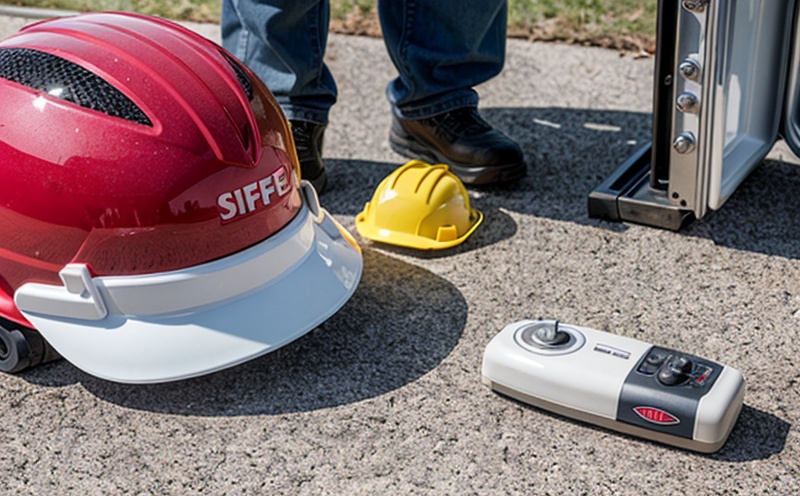ISO 18834 Search and Rescue Transponder (SART) Testing
The International Organization for Standardization's ISO 18834 standard provides a robust framework for the testing of Search and Rescue Transponders (SART). SARTs are critical safety devices designed to assist in locating people at sea in distress. These transponders emit signals that can be detected by lifeboats, helicopters, or other rescue equipment equipped with the appropriate receivers.
The ISO 18834 standard ensures that manufacturers of SARTs meet stringent requirements for performance and reliability. Compliance with this standard is mandatory for SARTs intended to be used in maritime environments. This service involves a comprehensive suite of tests designed to evaluate various aspects of SART functionality, including signal emission, response time, and durability under harsh conditions.
Our laboratory uses advanced instrumentation to simulate real-world scenarios that these devices might encounter during deployment. For instance, we can replicate the effects of saltwater corrosion, temperature variations, and electromagnetic interference on SART performance. Our team of experts ensures meticulous adherence to ISO 18834 standards, providing detailed reports that outline all test results and any discrepancies from specifications.
Compliance with ISO 18834 is crucial for maritime safety as it directly impacts the reliability of rescue operations. By ensuring that SARTs meet these rigorous testing protocols, we contribute to enhancing the overall safety of seafaring vessels and their crews. Our laboratory's expertise in this field allows us to offer services tailored not only to compliance but also to the enhancement of product performance.
Our testing process involves several key steps:
- Initial inspection and documentation
- Environmental conditioning to simulate real-world conditions
- Signal emission tests to ensure proper operation
- Durability and robustness tests under various environmental stressors
- Evaluation of response time and accuracy
- Comprehensive reporting and certification
The importance of ISO 18834 cannot be overstated, especially in the context of maritime safety. The standard sets benchmarks for performance that are essential for ensuring that SARTs function correctly when needed most. By providing these services, we help manufacturers meet regulatory requirements and enhance the safety of their products.
| Test Parameter | Description |
|---|---|
| Signal Emission | Tests whether the SART emits signals in accordance with specified frequencies and power levels. |
| Response Time | Evaluates how quickly the SART responds to a signal from a rescue vessel or helicopter. |
| Durability | Assesses the device's ability to withstand environmental factors such as saltwater, humidity, and temperature fluctuations. |
| Robustness | Tests for resistance against mechanical impacts and drops from various heights. |
| Acceptance Criteria | Description |
|---|---|
| Signal Emission | The SART must emit signals within a specified frequency range with minimal deviation from the expected power level. |
| Response Time | The SART should respond to a signal within a predefined time frame, typically under 10 seconds. |
| Durability and Robustness | The device must pass durability tests without any significant performance degradation or failure. |
Our laboratory is equipped with state-of-the-art facilities that can replicate a wide range of environmental conditions. This allows us to conduct thorough testing to ensure that the SARTs meet all specified criteria. Our team of experienced engineers and technicians ensures that every test is conducted accurately and consistently, providing reliable results.
Benefits
The benefits of ISO 18834 Search and Rescue Transponder (SART) Testing are numerous and extend beyond mere compliance with regulatory requirements. By undergoing these tests, manufacturers can ensure that their SARTs meet the highest standards of performance and reliability.
Enhanced Safety: Reliable SARTs play a crucial role in saving lives during maritime emergencies. Ensuring compliance with ISO 18834 helps guarantee that these devices perform as expected when deployed, thereby enhancing overall maritime safety.
Regulatory Compliance: Meeting the requirements of ISO 18834 is not only essential for compliance but also a demonstration of commitment to quality and safety. This can be particularly beneficial in securing certifications and approvals from relevant authorities.
Market Differentiation: By exceeding the minimum standards set by ISO 18834, manufacturers can differentiate their products in the market. This can lead to increased customer trust and loyalty, as well as a competitive edge over competitors who do not meet these stringent requirements.
Improved Product Quality: The rigorous testing process involved in ISO 18834 ensures that only high-quality SARTs make it to the market. This can lead to improved product quality and reliability, which are critical factors for any maritime safety device.
Quality and Reliability Assurance
The process of ensuring quality and reliability in ISO 18834 Search and Rescue Transponder (SART) Testing involves a series of stringent checks and balances. Our laboratory employs a robust methodology to ensure that every SART undergoes comprehensive testing, from initial inspection to final certification.
Initial Inspection: The first step in the process is a thorough inspection of the SART to ensure it meets all physical specifications. This includes checking for any visible damage or defects that could affect performance.
Environmental Conditioning: Once the initial inspection is complete, the SART undergoes environmental conditioning tests to simulate real-world conditions. These tests include exposure to saltwater, humidity, and temperature fluctuations to ensure the device can withstand these harsh environments.
Signal Emission Tests: The next step involves testing the signal emission capabilities of the SART. This ensures that the device emits signals within specified frequency ranges and power levels, which are critical for detection by rescue vessels or helicopters.
Durability and Robustness Tests: These tests assess the SART's ability to withstand mechanical impacts and drops from various heights. The goal is to ensure that the device remains functional even after exposure to severe conditions.
Evaluation of Response Time: Finally, the response time of the SART is evaluated to ensure it meets the required performance standards. This involves testing how quickly the device responds to a signal from a rescue vessel or helicopter.





